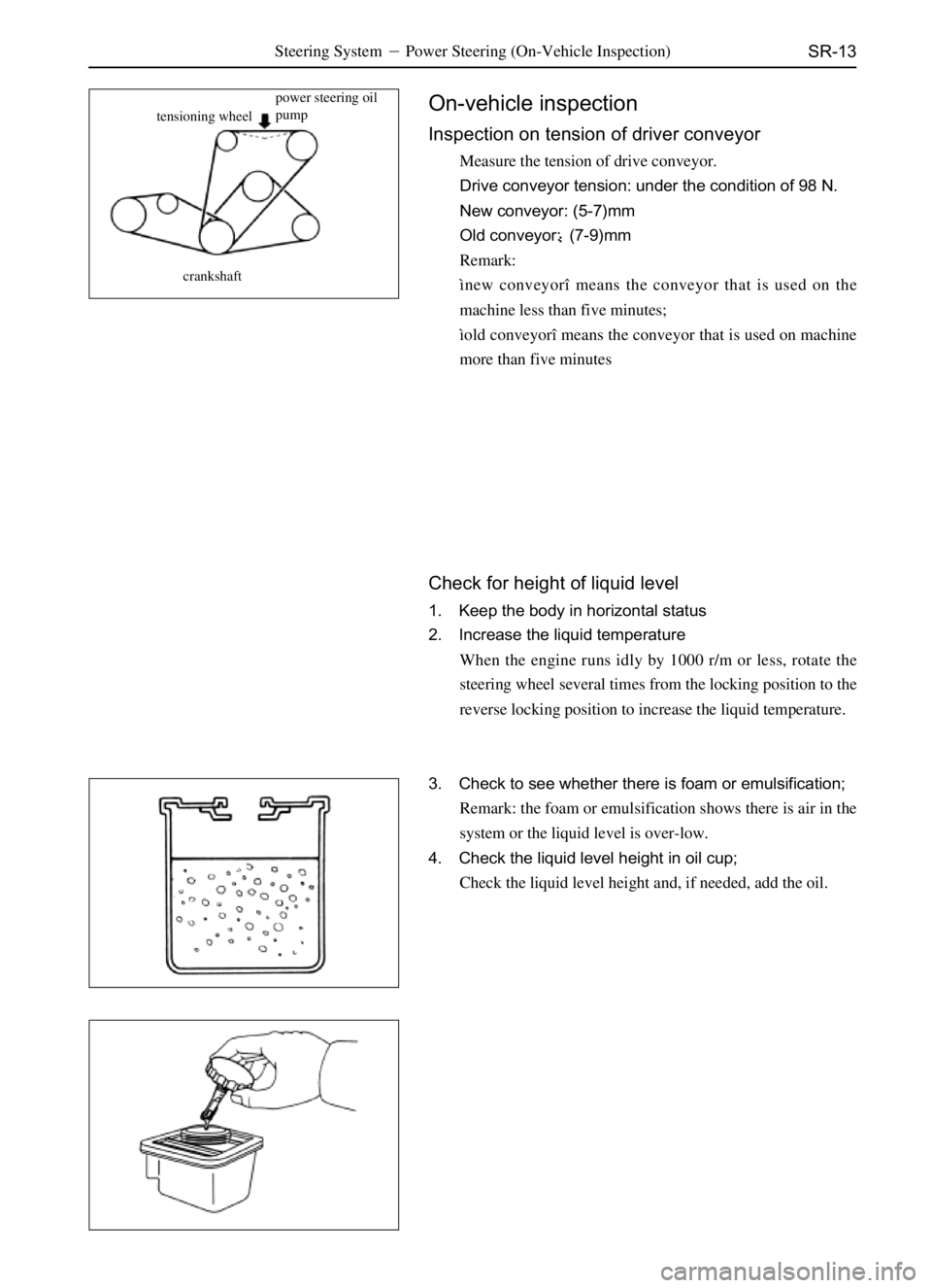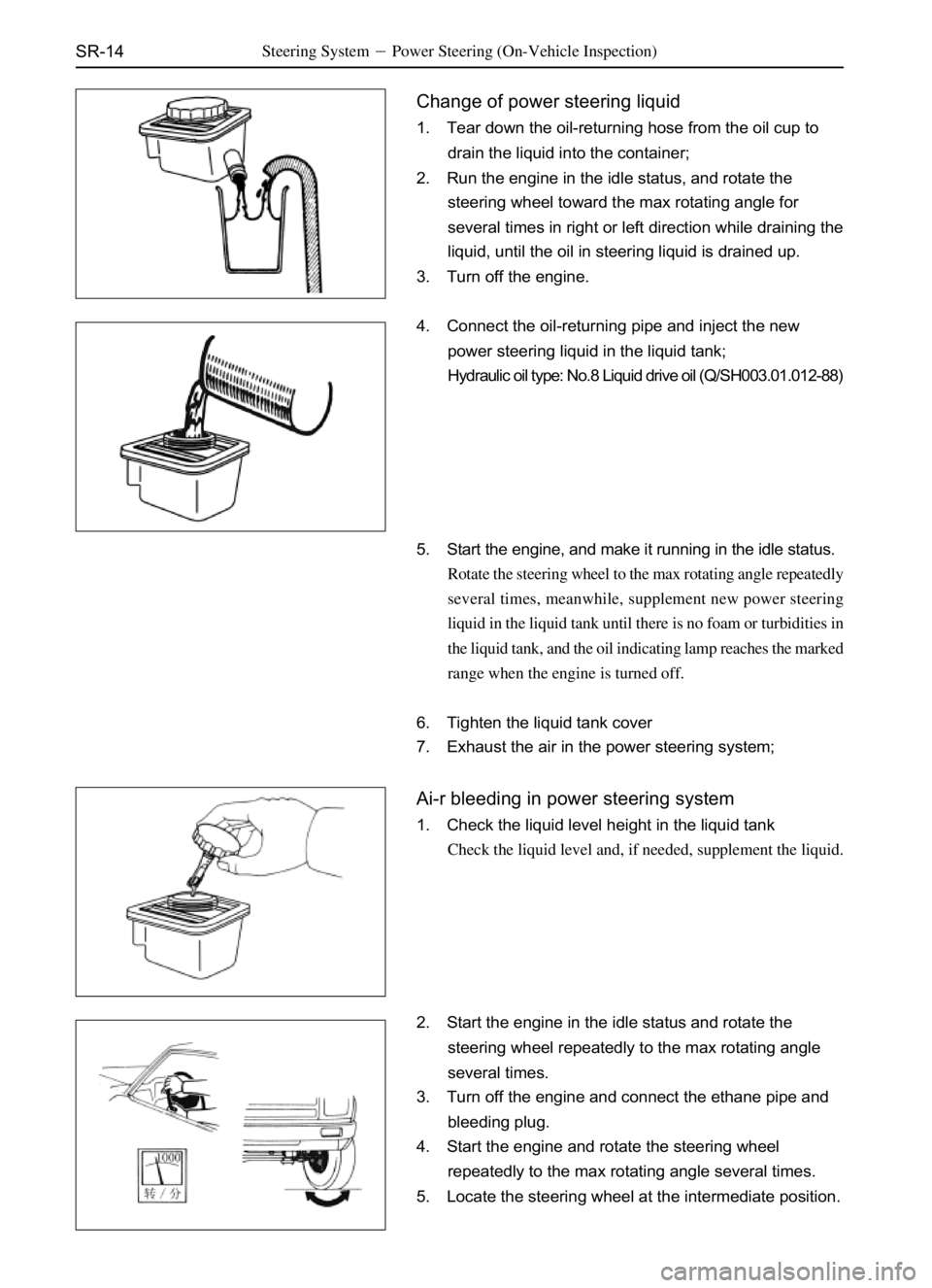Page 223 of 484
BR-12Brake System�Vacuum Booster
4. Mount the pedal return spring.
5. Mount the brake master cylinder
(see Page BR-8)
6. Connect the hose and the vacuum booster.
7. Fill the oil cup with brake liquid and exhaust the air in
braking system.
(see page BR-6)
8. Check the liquid leakage;
9. Check and adjust the brake pedal
(See page BR-5)
10. Check the operation
(See Page BR-6)
Page 225 of 484

BR-14
Brake pad change
Remark: Check the thickness of the friction material of brake
pad through the observation hole on caliper body after the
vehicle covers thirty thousand; if the thickness fails to fall
within the specified range, change is required. (If the brake is
used often, the thickness of friction materials of brake
pad is required to check whether it is within the specified
range after the vehicle covers more than ten thousand,
if not, change it.
1. Tear down the front wheel;
2. Check the thickness of friction material of brake pad:
Check the thickness of friction material of brake pad through
the observation hole on caliper body, if it fails to be within the
specified range, change it.
Min thickness: 2.0mm
3. Raise the wheel-brake cylinder:
(a) Tear down the short bolts of sliding sleeve;
(b) Uplift the wheel brake pump and hang it with rope to
protect the brake oil pipe.
Remark: Do not loosen the brake oil pipe and the bleeding plug.
4. Tear down the following parts:
(a) Two braking pads;
(b) Two silent pad clusters;
(c) Four braking pad lock plates.
Braking System�Front Brake (Dr)
Page 251 of 484
BR-40
7.Mount the front brake shoe:
(a) Mount the lower tension spring between the front shoe
and the back shoe.
(b) Mount the front brake shoe in such manner that the end
shoe is inserted in the wheel-brake cylinder, and mount
correctly the adjuster.
(c) Mount the pressure spring, pressure spring cap and
claming pin.
Notice: Do not let the oil or lubricant touch the brake
shoe.
(d) Mount the upper tension spring.
8. Check the operation of self-adjusting mechanism.
(a)Move the parking brake lever of rear brake shoe forward
and backward as shown in the drawing, check the self-
adjusting screw arbor to see whether it can rotate or not,
if not, check the rear brake to see which part has problem.
(b) Adjust the adjuster length and shorten it as can as possible.
(c) Mount the brake drum.
(d) Drag the parking brake lever to the max distance until no
quack-quack is heard. Braking System�Rear Brake (SF)
Page 258 of 484

SR-2
Notice
The parts change should be conducted correctly because
any error will affect the properties of steering system, or lead
to accidental or damage when driving.
Troubleshooting
Trouble Causes Inspection items
Unsuitable tire inflation
Insufficient lubricant
Over-large inclination
Steering gear joint wear
Lower swing arm ball head wear
Steering column seize-up
Steering gear unsuitable adjustment or damage
Power steering conveyer looseness
Over-low liquid level in oil cup of steering pump
Failure in power steering mechanismInflate the tire to specified pressure
Lubricating the hanging devices
Check the Alignment of Front Wheel
Change the Steering gear joint
Change the lower swing arm ball
head;
Check the steering column
Adjust or repair the gear.
Adjust the conveyor.
Check the steering pump oil cup
Check the power steering devices
Poor returning
Unsuitable tire inflation
Insufficient lubricant
Incorrect wheel alignment
Steering column seize-up
Steering gear unsuitable adjustment or damageInflate the tire to specified pressure
Lubricating the hanging devices.
Check the Alignment of Front
Wheel
Check the steering column
Change the steering gear.
Over-large playFront wheel bearing wear
Steering drive shaft yoke wear
Lower swing arm ball head wear
Steering gear joint wear
Steering gear unsuitable adjustment or damageChange the front bearing
Change the steering drive shaft
Change the swing arm ball head
Change the steering gear joint
Change the steering joint
Abnormal noise
Steering drive lever looseness
Steering gear joint wear
Steering gear unsuitable adjustment or damage
Oil lack or poor sealing of steering machine.Tighten the steering drive lever
Change the steering gear joint
Change the steering gear
Add the oil or change the sealing
washer Steering system inspection
on vehicle.
Steering System�Notice and Troubleshooting
Difficulty in steering
Page 259 of 484

SR-3Steering System�On-vehicle Inspection
max play
On-vehicle Inspection
Steering wheel play
1.SR-18Check to see whether the steering wheel play is
correct;
Park the vehicle stably and align the tires in correct direction,
press the steering wheel with finger and swing it in left and
right direction. The play should not exceed the max play.
(Max play) �6�(Dr SF)
If the play is nor correct, adjust or repair the steering wheel as
requirement.
2. Adjust the steering wheel play:
(a) Align the wheel forward precisely;
(b) Loosen the locking nuts of steering gear;
(c) Rotate the adjusting screws of steering gear clockwise to
reduce the steering wheel play, while contrarotate the
adjusting screws to increase the steering wheel play.
Remark: screw the adjusting screws and enlarge the play a
little each time to check the adjusted play.
3. Check to see whether there is steering inconvenience
Rotate the steering wheel by half round in right and left
direction to check whether the play is correct, and whether the
wheel runs smoothly or any seize-up in its running.
4. Fix the adjusting screws and fasten the adjustable nut.
Oil level height
Check the oil level height in the steering gear housing.
Oil level height: flush with the filler opening.
If there oil is insufficient, add the gear oil and check to see
whether there is oil leakage.
Page 269 of 484

SR-13Steering System�Power Steering (On-Vehicle Inspection)
tensioning wheelpower steering oil
pump
crankshaftOn-vehicle inspection
Inspection on tension of driver conveyor
Measure the tension of drive conveyor.
Drive conveyor tension: under the condition of 98 N.
New conveyor: (5-7)mm
Old conveyor:�(7-9)mm
Remark:
ìnew conveyorî means the conveyor that is used on the
machine less than five minutes;
ìold conveyorî means the conveyor that is used on machine
more than five minutes
Check for height of liquid level
1. Keep the body in horizontal status
2. Increase the liquid temperature
When the engine runs idly by 1000 r/m or less, rotate the
steering wheel several times from the locking position to the
reverse locking position to increase the liquid temperature.
3. Check to see whether there is foam or emulsification;
Remark: the foam or emulsification shows there is air in the
system or the liquid level is over-low.
4. Check the liquid level height in oil cup;
Check the liquid level height and, if needed, add the oil.
Page 270 of 484

SR-14Steering System�Power Steering (On-Vehicle Inspection)
Change of power steering liquid
1. Tear down the oil-returning hose from the oil cup to
drain the liquid into the container;
2. Run the engine in the idle status, and rotate the
steering wheel toward the max rotating angle for
several times in right or left direction while draining the
liquid, until the oil in steering liquid is drained up.
3. Turn off the engine.
4. Connect the oil-returning pipe and inject the new
power steering liquid in the liquid tank;
Hydraulic oil type: No.8 Liquid drive oil (Q/SH003.01.012-88)
5. Start the engine, and make it running in the idle status.
Rotate the steering wheel to the max rotating angle repeatedly
several times, meanwhile, supplement new power steering
liquid in the liquid tank until there is no foam or turbidities in
the liquid tank, and the oil indicating lamp reaches the marked
range when the engine is turned off.
6. Tighten the liquid tank cover
7. Exhaust the air in the power steering system;
Ai-r bleeding in power steering system
1. Check the liquid level height in the liquid tank
Check the liquid level and, if needed, supplement the liquid.
2. Start the engine in the idle status and rotate the
steering wheel repeatedly to the max rotating angle
several times.
3. Turn off the engine and connect the ethane pipe and
bleeding plug.
4. Start the engine and rotate the steering wheel
repeatedly to the max rotating angle several times.
5. Locate the steering wheel at the intermediate position.
Page 271 of 484
SR-15Steering System�Power Steering (On-Vehicle Inspection)
6. Exhaust the air in steering system:
(a) Loosen the bleeding plug;
(b) Screw up the bleeding plug when there is no air bubble
exhausted from the pipeline.
Notice: take care not let the ethane pipe slide from the
bleeding plug, because the liquid is high in temperature
and pressure.
7. Check to see whether there is air bubble or turbidities
in the oil cup, and ensure the liquid level will not
exceed the max value when the engine stops,
Measure the liquid height under the condition of engine running,
then turn off the engine and measure the liquid height again.
In case any problem is found, repeat the approaches of (5) and
(6) in Power Steering Liquid Change. If the problem still
exists, repair the power steering oil pump.
RPM RPM